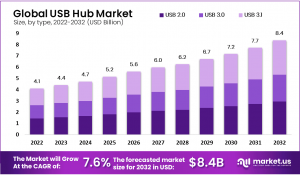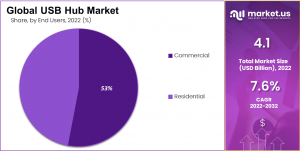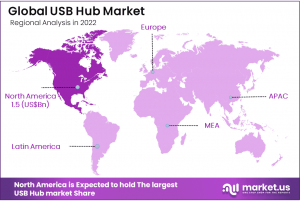USB Hub Market is projected to reach USD 8.4 Billion by 2032, growing from USD 4.4 Billion in 2023 at a CAGR of 7.6% during the forecast period.
”
NEW YORK, NY, UNITED STATES, January 23, 2025 /EINPresswire.com/ — **Report Overview**
The Global USB Hub Market is projected to reach a value of approximately USD 8.4 billion by 2032, up from USD 4.4 billion in 2023, with a compound annual growth rate (CAGR) of 7.6% over the forecast period from 2023 to 2032.
A USB hub is a device that expands the number of available USB ports on a computer or other electronic device, allowing users to connect multiple peripherals simultaneously. It functions by providing additional data and power channels through a single USB connection, enabling devices such as keyboards, mice, printers, external storage drives, and smartphones to operate without requiring additional ports from the host system. USB hubs are commonly used in both consumer and professional environments, from home offices to large enterprises, to enhance device connectivity and optimize productivity.
The USB hub market encompasses the design, production, and distribution of these devices across various sectors, including consumer electronics, enterprise solutions, and industrial applications. With the growing reliance on USB-powered devices and the increasing number of USB-enabled gadgets, the market has seen steady demand and innovation. The market’s growth is primarily driven by the ongoing trend toward portable and compact computing solutions, with users and businesses seeking seamless connectivity for multiple devices through a single port.
Request Your Sample Report Today for In-Depth Insights and Analysis at https://market.us/report/usb-hub-market/request-sample/
Key growth factors for the USB hub market include the widespread adoption of USB 3.0 and 3.1 standards, which offer faster data transfer speeds and greater power output, and the surge in remote work, which has increased the need for efficient device management. Demand is further fueled by the rise in smart homes, IoT devices, and gaming peripherals. Significant opportunities lie in the development of high-speed hubs with enhanced functionality, such as power delivery capabilities and support for 4K or 8K video output, which cater to both consumer and enterprise demands for advanced connectivity solutions.
**Key Takeaways**
~~ The Global USB Hub Market is projected to grow from USD 4.4 billion in 2023 to USD 8.4 billion by 2032, at a CAGR of 7.6%, driven by increasing demand for multi-device connectivity and advancements in USB technologies.
~~ USB 3.0 leads the market by type, capturing 58% of the market share in 2023, thanks to its optimal balance ~~ between high-speed data transfer and cost-effectiveness.
~~ The commercial segment dominates the end-user analysis with a 53% share in 2023, primarily driven by the widespread use in enterprise environments that require extensive connectivity solutions.
~~ North America holds the largest market share at 37.2% due to strong consumer electronics adoption and advanced IT infrastructure.
**Market Segmentation**
By Type Analysis
In 2023, USB 3.0 dominated the USB Hub market by type, capturing over 58% of the market share. Its success is attributed to its balance of cost-effectiveness and high data transfer speeds (up to 5 Gbps), along with backward compatibility. USB 3.0 is widely adopted in consumer electronics, computing devices, and industrial applications. USB 2.0 still maintains relevance in cost-sensitive applications, while USB 3.1, with speeds of up to 10 Gbps, is gaining traction in high-performance sectors like gaming and video production. Despite the rise of newer standards, USB 3.0 remains the market leader in 2023.
By End-User Analysis
In 2023, the commercial segment led the USB Hub market, accounting for over 53% of the market share. This dominance is driven by the growing use of multi-port USB hubs in workplaces, educational institutions, and healthcare sectors, where numerous devices need to be connected simultaneously. The demand for efficient hubs to support peripherals like printers, scanners, and external storage devices has bolstered the commercial sector’s growth. While the residential segment also saw growth due to home offices, gaming setups, and entertainment systems, it remains smaller in comparison to the commercial sector, which benefits from higher volume requirements and frequent usage in business environments.
**Key Market Segments**
By Type
~~ USB 2.0
~~ USB 3.0
~~ USB 3.1
By End-User
~~ Residential
~~ Commercial
**Driving factors**
Increasing Adoption of Remote Work and Digitalization
The global shift towards remote work and digitalization has accelerated the demand for USB hubs. As businesses and individuals rely on multiple devices simultaneously—laptops, monitors, printers, external storage, and other peripherals the need for additional USB ports has grown. USB hubs allow seamless connectivity across devices, making them essential tools for enhancing productivity in work-from-home (WFH) setups and digital workplaces. As professionals rely more on their personal devices for work, the ability to connect multiple peripherals has become indispensable, driving the need for advanced USB hubs that offer multiple ports with high-speed data transfer and charging capabilities.
**Restraining Factors**
Competition from Wireless Connectivity Solutions
One of the major restraints in the growth of the USB hub market is the increasing adoption of wireless connectivity solutions. Technologies such as Bluetooth, Wi-Fi, and wireless charging are offering alternative ways to connect and power devices without the need for physical connections. With the rise of these wireless solutions, some users and businesses are opting to reduce their dependency on wired peripherals and USB hubs, particularly as wireless technology becomes more efficient and widespread. This shift towards wireless devices, such as wireless keyboards, mice, and even external drives, poses a direct challenge to the traditional role of USB hubs.
**Growth Opportunity**
Emergence of USB 4.0 and Faster Data Transfer Technologies
The launch of USB 4.0 and other high-speed data transfer technologies presents a significant opportunity for the USB hub market. USB 4.0 offers data transfer speeds of up to 40Gbps, doubling the capabilities of its predecessor, USB 3.2, and enabling faster, more efficient connections for a wide range of devices. This increase in speed not only enhances the performance of peripherals but also allows for greater versatility in the types of devices that can be connected. USB hubs with USB 4.0 support can cater to the increasing demand for high-bandwidth applications, such as 4K and 8K video streaming, gaming, and data-heavy content creation, expanding their appeal across different industries.
**Latest Trends**
Compact and Multi-Functional Designs
The trend toward compact and multi-functional designs is reshaping the USB hub market in 2024. As consumers and businesses seek more portable and space-saving solutions, USB hubs are evolving to offer a combination of functionality and design efficiency. Today’s USB hubs are increasingly compact, sleek, and capable of providing not just additional USB ports but also HDMI, Ethernet, SD card readers, and even power delivery options. This shift towards multi-port hubs caters to the demand for all-in-one solutions, allowing users to minimize cable clutter while maximizing their connectivity options in a single device.
"Order the Complete Report Today to Receive Up to 30% Off at https://market.us/purchase-report/?report_id=103253
**Regional Analysis**
North America: Dominating USB Hub Market with 37.2% Share in 2023
North America holds the largest market share in the USB hub market at 37.2%, valued at US$ 1.5 billion in 2023. This dominance is driven by strong demand across consumer electronics, IT, and automotive industries, with major manufacturers and high technology adoption fueling growth. Europe is experiencing steady growth, driven by digitalization and rising demand for USB hubs in consumer electronics and industrial sectors. While it lags behind North America, its market share remains significant, supported by technological innovation and a robust consumer base.
Asia Pacific is witnessing rapid expansion, particularly in countries like China, Japan, and India. The region benefits from booming demand in consumer electronics and IT, with low manufacturing costs and a strong export market contributing to its fast-growing share in the global USB hub market. Latin America's USB hub market shows moderate growth, driven by rising demand in consumer electronics. Economic challenges may limit expansion, but increasing digital adoption and infrastructure investment offer growth potential in the coming years.
The Middle East & Africa region shows slower growth, limited by lower demand for USB hubs and slower technological adoption. However, growing infrastructure and interest in connected devices may gradually boost demand in this region.
**Key Players Analysis**
In 2024, the Global USB Hub Market continues to be dominated by established players, each contributing unique technological innovations. Anker Innovations Co. Ltd stands out for its strong consumer-oriented product offerings, leveraging its brand recognition in the portable power and connectivity sectors. Conceptronic, with its focus on cost-effective solutions, is well-positioned to cater to budget-conscious consumers while maintaining competitive functionality. Vaunix Technology Corp. has carved a niche in advanced, professional-grade USB hubs, appealing to industries that demand high-performance solutions, such as telecommunications and electronics.
Belkin International, Inc., known for its high-quality, premium-priced products, consistently strengthens its presence through innovation and robust distribution networks. Honeywell International brings expertise in integrated solutions, pushing the boundaries of IoT and automation. Meanwhile, Texas Instruments focuses on providing USB hub technologies with a focus on semiconductor innovation, impacting performance and scalability. These players, alongside emerging brands, are driving continued growth and diversification within the USB hub market.
!! Sample the Report Structure with Our PDF Download !!
Top Key Players in the Market
~~ Anker Innovations Co. Ltd
~~ Conceptronic
~~ Vaunix Technology Corp.
~~ Belkin International, Inc.
~~ Honeywell International
~~ Texas Instruments
~~ Other Key Players
**Conclusion**
The Global USB Hub Market is poised for significant growth, with a projected value of USD 8.4 billion by 2032, growing at a CAGR of 7.6%. The increasing demand for multi-device connectivity, the rise of remote work, and advancements in USB technologies are key drivers of this growth. While USB 3.0 currently leads the market, innovations such as USB 4.0 and the demand for compact, multifunctional designs present new opportunities for further expansion. Despite competition from wireless solutions, the market remains robust, with North America maintaining a dominant position. With continued technological advancements and evolving user needs, the USB hub market is set to meet the increasing connectivity demands across various industries.
Lawrence John
Prudour
+91 91308 55334
Lawrence@prudour.com
Visit us on social media:
Facebook
LinkedIn
Legal Disclaimer:
EIN Presswire provides this news content “as is” without warranty of any kind. We do not accept any responsibility or liability
for the accuracy, content, images, videos, licenses, completeness, legality, or reliability of the information contained in this
article. If you have any complaints or copyright issues related to this article, kindly contact the author above.
![]()



